From Glitter to Macaroni (Part 1): Downsizing and Organizing Children’s Art
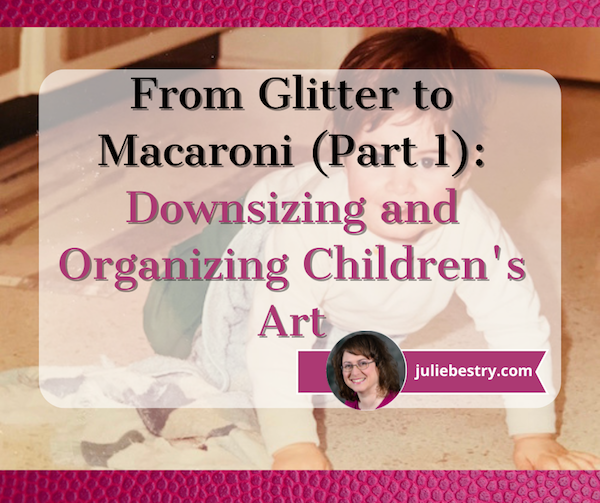
I suspect that in the past (almost) 18 years, Paper Doll has covered the entire span of paper organizing topics. Just in the past few years, we’ve reiterated the essentials for all the documents that keep your financial, legal, medical, household, and personal life running:
- Paper Doll Shares 12 Kinds of Paper To Declutter Now
- Reference Files Master Class (Part 1) — The Essentials of Paper Filing
- Reference Files Master Class (Part 2) — Financial and Legal Papers
- Reference Files Master Class (Part 3) — Medical Papers
- Reference Files Master Class (Part 4) — Household and Personal Papers
We’ve also delved into specialty topics, like paperwork hoops to jump through for handling insurance, changing your name, helping a loved one with Medicare, or organizing recipes, and we’ve repeatedly looked at organizing solutions for storing and organizing papers:
- Organize for an Accident: Don’t Crash Your Car Insurance Paperwork [UPDATED]
- Paper Doll’s Ultimate Guide to Legally Changing Your Name
- A New VIP: A Form You Didn’t Know You Needed
- Calm Cooking Chaos (Part 1): Organize Your Paper Recipes
- Paper Doll Refreshes Your Paper Organizing Solutions
- Paper Doll’s Guide to Picking the Right Paper Planner
However, after delving deeply into the Paper Doll archives, I found that it has been 13 years since I’ve visited the topic of one of the most unwieldy types of paper: children’s art!
With the school year ending and all those lockers, cubbies, and book bags getting cleaned out, this is the perfect time to refresh our look at children’s art.
ARE YOU STRUGGLING TO RUN AN ART GALLERY FOR TINY HUMANS?
Parents (and grandparents) sometimes find themselves with secondary careers as curators of pop-up museums catering to a very narrow category of visual media. Do you often imagine yourself the director of something along the lines of the Family History Museum of Kindergarten Arts and Crafts (FHMKAC) or the Modern Museum of Macaroni (MMM)?
With most types of paperwork, we can determine what to keep and for how long based on document destruction and records retention schedules, such as those I provide in Do I Have To Keep This Piece of Paper?
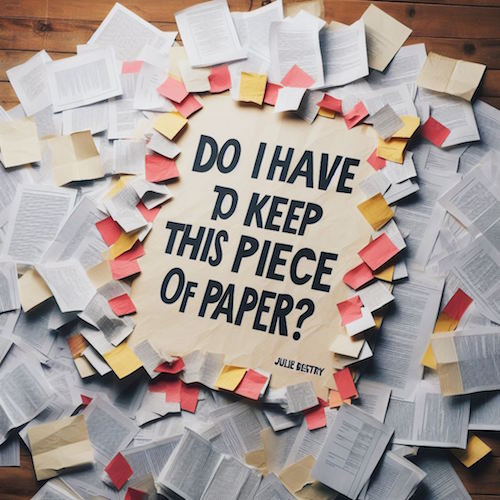
For items without legal or financial rules, we can analyze the situation to see what makes the most sense. If we opt for paper instead of digital users manuals, a series of simple file folders and binders will suffice, and the documents can be discarded when we no longer own the gadget. Our clippings for a dream wedding or trip to Spain generally go away one the event or trip has passed and the photographic of the experience supplants the files.
But children’s art? Figuring out how and when to let that go may be a toughie for several reasons. For example:
- You’re a sentimental softie and it’s hard for you to let go of anything related to your kids. (You’re my client who kept the purple mimeographed instructions on how to get to the right school administrative office to register your child for first grade…in 1978.)
- You haven’t got a clue what most of the art is supposed to be. Your toddler hasn’t quite managed enunciating, so you’re taking the stance that a picture is worth a thousand words.
- You’re a fairly new parent and haven’t previously experienced the inundation of art that comes from tiny humans creating new projects every single day.
- You are certain that your child is a prodigy. You assume everything is stellar and that museums someday be falling over themselves to acquire Little Dude or Dudette’s Early Period work.
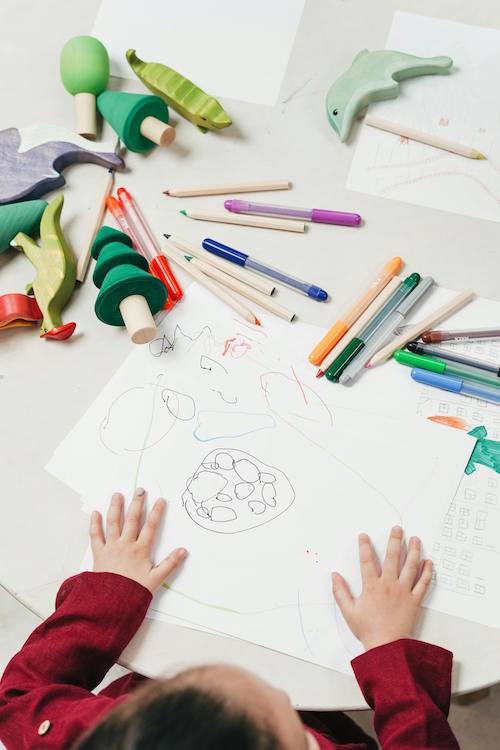
Children’s Art Photo by cottonbro studio at Pexels
- Your family of origin never organized art. Either your parents saved everything you created or it all went in the bin. If it’s the latter, you weren’t taught the tricks of separating wheat from chaff in the tiny tot art world. If it’s the latter, you may resent not being able to trace your MiniMe artistic path and resentment fuels your unwillingness to make judgements about your kid’s artwork.
- You’re digital in almost every other area of your life. You receive and pay bills online, and rarely even receive mail. Your child’s school sends every message through a digital portal. You and your spouse keep everything in Dropbox or OneNote or Evernote. You may not even have experience managing paperwork of any kind, but paper without labels, dates, or clear categories makes your eyes glaze over.
- You’ve tried to declutter, but the art has taken over. You’d wave a white flag, but every white piece of paper and white t-shirt in your home has already been turned over to your picayune Picasso. At this point, you no longer recall what color your refrigerator is because the doors and sides are covered with all of the major artistic methods: watercolor, oil(y Play-doh or sticky jam-hands), and mixed media (painted, sparkly macaroni)!
Never fear. Whatever your situation, there’s a path to making sense of all those artistic endeavors.
HOW TO CULL CHILDREN’S ART
When children are very young, every artistic effort may seem like a masterpiece, but soon enough, parents can become overwhelmed by the embarrassment of finger-painted riches. At some point, you realize you’re either going to have to start buying Frigidaires in bulk, or you’re going to run out of display space in the kiddie art gallery you used to call your home.
There are no records retention schedules for crayoned drawings of your family, each with out-of- proportion body parts in front of a boxy house with a yellow sun in the upper left corner of the page. Culling children’s art is neither an art nor a science, but a labor of love wrapped in papier maché and held in place with colored pipe cleaners.
Culling children's art is neither an art nor a science, but a labor of love wrapped in papier maché and held in place with colored pipe cleaners. Click To TweetWe’ll start with looking at the basics for winnowing the collection, and next week, we’ll move on to both standard and creative ways to display the artwork. Remember these general concepts:
Kids live in the moment
For children, the charm of creating of art is the experience making it. Unlike adults, they rarely create art to get adulation or social media likes. Whatever they’re doing right now is what matters to them.
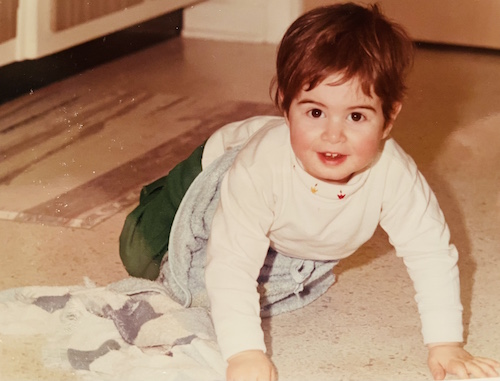
Tiny Paper Doll in Deep Work Mode, Circa 1968
A toddler is enjoying the experience of goopy blue and yellow making green under his fingers.
A first grader delights in the representational aspect of getting the whole family, plus Bluey and Elsa, onto the front yard; the fact that Frozen’s princess towers over Dad is entirely beside the point.
New art is good art
Because kids are little art factories, the stuff arrives fast and furiously, and their favorite pieces are whatever they’ve made most recently. Praise it! Stick to age-appropriate questions and comments (“Is that blue?” “Wow, look how tall Daddy is! Oh, that’s actually a spider? What a cool spider!”)
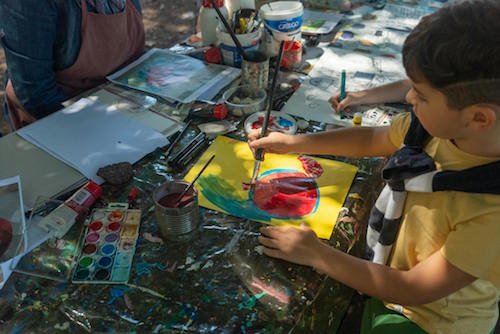
Little Boy Creating Art Photo by Oleksandr P on Pexels
But know that they’ll move on from their blue periods with nary a glance backward, unless you make them think they’re supposed to care about the past efforts.
Be an art collector — for the short term
Don’t feel like you have to display all art, either immediately or at all. Your tiny human is new to the planet and doesn’t know there’s a cultural expectation of putting every piece of art on the fridge or on display in general.
Your tiny human is new to the planet and doesn't know there's a cultural expectation of putting every piece of art on the fridge or on display in general. Click To TweetMaybe your child will angle to have art displayed (or at least shown off) each night when parents have returned home from work. If the tidiest and easiest way to do that is to display today’s illustrations on the fridge, that’s cool, but if possible, from an early age, consider this like a Today’s Specials board at a café. But tomorrow or next week, they can come down to make way for the next collection.
Perhaps your child is such a little art factory that morning crafts have been forgotten by the time the lunchtime juice box has been abandoned. Try to follow your little one’s cues instead of making too big a deal of the retention aspect. Again, they live in the moment, and so should you!
Separate the masterpieces from the reproductions
We’ve all seen the coloring-book outline of a human hand turned masterfully into a Thanksgiving Tom Turkey with the application of crayons.

Thanksgiving! Happy Thanksgiving Turkey Hand Print Magnet designed and sold by aarniviita on Teepublic
It’s the pre-school version of paint-by-numbers and is a mere reproduction. As you start thinking about what to keep vs. save, yield household space for the masterpieces, the originals that only your child could have made.
Schedule a Weekly Curation Meeting
You are the head curator of this museum; the tots are your assistants. Give yourself permission to collect the week’s art and evaluate it all at once. A good option is a large (clean) pizza box, one for each child. It’ll corral the art until you’re ready for the weekly Curation Meeting.
- Communicate — Once you develop a process, discuss it with your child on an age-appropriate basis. Your two-year-old doesn’t need to know why every finger paint and scribble seems to have a short-term showing; your first grader, however, needs to understand (and eventually participate) in the decision process.
- Create limits and set boundaries — Explain that you have limited space and that by letting go of some art, you are making room to highlight new creations. This can be part of a larger, ongoing discussion with your children regarding how the world is filled with options but your home is for the most useful and beautiful things, and how making decisions about what to keep and what to send on its way is all part of life.
- Choose the best — Involve junior in selecting a few special pieces from that week to keep. You may ask, “What’s your super-duper favorite?” but recognize that your child may have very different evaluative criteria, picking a piece because it was fun to make or because she got to share the best crayon with her BFF. You’re teaching decision-making and value assessment, but remember that perspective, especially with regard to art, is personal!
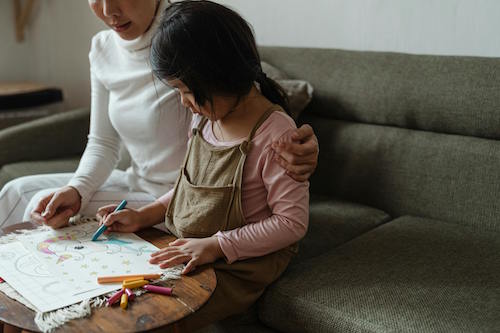
Mom and Child Discussing Art Photo by Ketut Subiyanto at Pexels
- Allow for sentiment — For new new parents, the process may be difficult, especially when your child is too young to weigh in, and every piece feels like proof of a milestone achieved. At this weekly stage, it’s OK to keep items that have special significance to you, such as the first drawing that actually looks like something, particular holiday-themed art, or pieces that reflect significant moments in your child’s development.
- Document the legacy — You may doubt me, but twenty years from now, you will be hard-pressed to figure out which of your formerly-tiny geniuses created that giant lizard-fish-horse-princess-robot. During your weekly curation meeting, pencil in the name of your little artist and the date on the reverse of the artwork.
Establish Regular Decluttering Rituals
Purging weekly is a great start to keep yourself from drowning in sparkly construction paper and 473 identical drawings of a tree. However, you’re going to want to establish periodic curation meetings to go back over the things you’ve kept during those weekly curation meetings.
When kids are younger, that might be monthly. Once they are in school, opt for a seasonal review. Go through the collected art at the end of each season or semester to decide what to keep and what to let go. If you fall behind throughout the year, at least be sure to wrap up the school year to collect what was most representative of the just-ended grade level.
Make this decluttering ritual one that fits your family’s style, whether formal or casual. No matter the tone, establish a routine purging session, a special event where you and your child review and reminisce before making decisions.
WHAT TO DO WITH ART YOU AREN’T KEEPING
Let’s face it. Not everything your child creates is going to go up on the wall of a museum. Most really need not go up on your fridge. (Yes, I’m sure grownup Angolo di Cosimo didn’t imagine his little drawing of a rich patron’s kid would be famous some day, but your two-year-old’s scribble using three different brown crayons just isn’t in contention for the Louvre or Uffizi.)
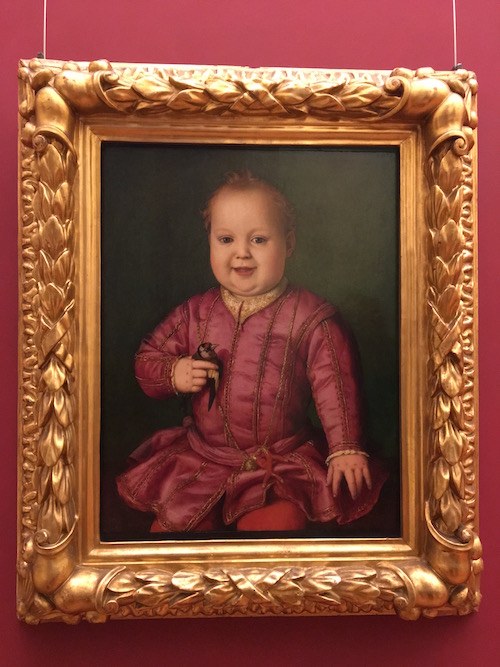
Portrait of Giovanni de’ Medici as a Child Holding a Goldfinch, circa 1545 by Agnolo di Cosimo. (I shot this at the Galleria degli Uffizi in Florence in September 2018.)
Toss
If it’s goopy, sticky, or critter-attracting, let it go (but do it after the kids go to sleep, as nobody needs to see their creations head to their ultimate resting places). If it’s got macaroni (or any other foodstuffs) stuck to it, let it go. Organic materials attract insects and creepy-crawlies, and while Mrs. Frisby and the Rats of NIHM might have literary merit, you don’t want the main characters coming by to sniff and taste the art at your house.
Recycle
If the artwork is on recyclable paper and not very sentimental, consider recycling it. For example, as long as it’s clean (and clear of organic materials), construction paper is recyclable. Make a point of knowing what types of paper are recyclable and which are not. For example, Kraft paper is recyclable, but tissue paper is not.
Gift
While you don’t want to inundate grandparents, older siblings off at college, or lonely neighbors with absolute mountains of art, it might help (when one or two pieces just barely fail to make the weekly cut) to share with loved ones.
Kids who are just mastering writing can “sign” their masterpieces, and you can add a note to Grandpa to explain what the piece actually is, if it’s not quite representational art (assuming you have a good guess at the content).
Donate
Some organizations or nursing homes appreciate receiving children’s artwork to brighten their spaces. There are also organizations like Fresh Artists which will enlarge, print, and display art in public spaces supported by corporate sponsors. Explore your local and regional options.
Repurpose
For for giving older art new life for a shorter duration, try it as:
- Gift Wrap: Use large-format art (such as the kind drawn on big rolls for Kraft paper) as unique wrapping paper for gifts.
- Craft Projects: Turn artwork into calendars, bookmarks, greeting cards, or other craft projects.
- Collages: Group smaller pieces into a collage to preserve memories in a compact form.
Next time, we’ll look at how to store favorite pieces of children’s art (but seriously, just what makes the cut!) and how to display the special pieces. Until then, start thinking about the places in your home where you might brighten things with whimsical displays of really modern art.




I love this. Great minds think alike, and we both hit the same topic this week but yours was a lot more fun to read!
I was just thinking about how our posts dovetail, as you talked about the larger issue of children’s paperwork, while mine was narrowed in on just the art. Thanks for thinking this was fun. When I was home, I got snaps of my old baby pics, so they’ll be popping up more often.
Kids’ art! In our household, they were incredibly prolific. In addition to the arts and crafts supplies we had for them at home, they also produced and brought home pieces from school.
We hung some, archived some, and released even more. We also loved using abstract and finger paintings as gift wrap. Bringing a uniquely wrapped gift to a kid’s birthday party always looked great and was appreciated. Add some lovely ribbon, and wow!
I also taught them pretty early on how to edit- keep the special ones and release the rest. Over time, both of our daughters got good at that.
Thank you for encouraging parents and sharing a process for honoring the creatives and also choosing the treasures.
What a great idea, to wrap gifts for others with abstract art and finger paints! A ribbon is good, but take a page out of Paper Mommy’s book and affix tiny wrapped candies, like Smarties. That was always a winner!
I assume I was a prolific (if terrible) artist. Not much went on the fridge, but my mom saved a lot of my writing, which is where the real zeal was spent. (A painting I made for my sister is still on the wall of her childhood bedroom, complete with sun in the upper left corner!)
Children’s artwork is a real issue for some people. They want to keep everything. I started giving a set-up system in a file box as a new baby gift. It was partial and usually something that the new parents hadn’t thought about yet. Yes, it’s years before they’ll use it, but it’s ready to go when they child starts school.
A pre-made file system for parents of newborns is great!
Meanwhile, I often wonder if parents could tell the difference between finger paintings or scribbles done by their own kids from those made by other kids, even in other generations. There’s real sentiment, and then there’s when they assume they have a sentimental attachment and hold on to things that don’t actually have meaning. It sure does take a lot of discussion!
I went through this process with the boxes of stuff I had saved from my girls’ childhood. I immediately realized why you shouldn’t hang onto anything made from edible materials… there were tiny bug exoskeletons all over the boxes LOL.
I found putting “like” pieces together also helped. Seeing that my daughter was into a certain type of drawing in a given year helped me pick the best one and pitch the rest.
I made them into photo books: one for preschool and one for elementary. I leave them out in our upstairs TV room. Periodically, they do pick them up and review them. I took your advice and wrote any information from the back or a label as a “title” for each piece, and it does mean a lot more!
There’s nothing that perks up a discussion like “exoskeletons!”
What a great idea, using the “like with like” test as a proving ground for picking the best from a themed collection of artwork. Smart!
I love that you turned them into photo books that they still review (but shhh, that’s for next week). 😉
I love your processes and advice! I think a key piece to remember for parents with younger kids is that the artwork will slow down as they get older, so the amount won’t be as much. I was in the camp of keeping way too much, but now that the kids are older, they can easily edit and cut down on it. I realized that I wasn’t keeping it for me but for them to have someday, and that helped shift the decision-making power to them. Great article! Thank you!
Thank you for your kind words. And yes, this process doesn’t go on forever. Few kids have art beyond fifth or sixth grade, and soon past that, kids usually take responsibility for archiving their own things. I hope that makes the whole process a little overwhelming for the parents of three-year-olds, buried under piles of similar-seeming scribbles!